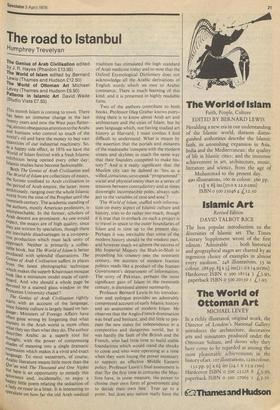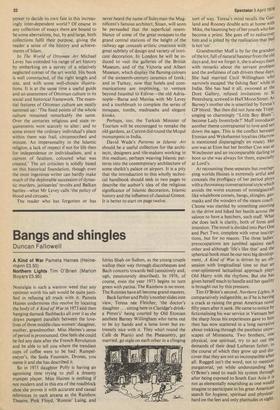The road to Istanbul
Humphrey Trevelyan
The Genius of Arab Civilisation edited by A. Hayes (Phaidon £13.95)
The World of Islam edited by Bernard Lewis (Thames and Hudson £12.50) Patterns in Islamic Art David Wade (Studio Vista £7.50)
This month Islam is coming to town. There has been an immense change in the last twenty years and now the West pays flatter- Mg, almost obsequious attention to the Arabs and Iranians who control so much of the world's oil and have the money to buy vast quantities of our industrial machinery. So, as a happy side effect, in 1976 we have the World of Islam festival with a fresh Islamic exhibition being opened every other day; Islamic studies have become fashionable. Both The Genius of Arab Civilisation and The World of Islam are collections of essays, the former confined to Arab civilisation in the Period of Arab empire, the latter, more ambitiously, ranging over the whole Islamic world from the time of the Prophet until the twentieth century. The academic standing of the authors, mostly American professors, is unimpeachable. In the former, scholars of Arab descent are prominent. As one would expect, the essays are of high quality, since they are written by specialists, though there are inevitable disadvantages in a co-opera- tive production which must lack unity of approach. Neither is primarily a coffee- table book, but The World of Islam is better Produced with splendid illustrations. The Genius of Arab Civilisation suffers in places from the latest photographic technique Which makes the superb Khairouan mosque look like a miniature model made of card- board. And why should a whole page be devoted to a stained glass window in the Princeton University chapel? The Genius of Arab Civilisation rightly starts with an account of the language, since Islamic culture is largely based on lan- guage: Ministers of Foreign Affairs have often gone wrong by forgetting that what Matters in the Arab world is more often What they say than what they do. The author descri
vcs
k Arabic as a superb tool for thought, with the power of compressing shades of meaning into a single dramatic expression which makes it a vivid and exact language. To most westerners, of course, Arabic literature means little more than the Qur'an and The Thousand and One Nights tit here is an opportunity to remedy this ignorance and, incidentally, to enjoy a nappy little poem relating the seduction of a lady en route in a litter. It is interesting to speculate on how far the old Arab medical
tradition has stimulated the high standard of Arab medicine today and to note that the Oxford Etymological Dictionary does not acknowledge all the Arabic derivations of English words which we owe to Arabic commerce. There is much learning of this kind, and it is presented in highly readable form.
Two of the authors contribute to both books. Professor Oleg Grabar knows every- thing there is to know about Arab art and architecture and the cities of Islam, but he uses language which, not having studied art history at Harvard, I must confess I find difficult to understand. What is meant by the assertion that the portals and minarets of the madrasehs 'compete with the modern streets and skylines in much the same way that their founders competed to make his- tory?' And is it really significant that the Muslim city can be defined as 'less as a willed, conscious, so to speak "programmed" social and physical entity than as a series of tensions between contradictory and at times downright incompatible poles, always sub- ject to the variables of time and area'?
" The World of Islam, stuffed with informa- tion on every aspect of Islamic culture and history, tries to do rather too much, though. it is true that to embark on such a project is to travel in space to the outer boundaries of Islam and in time up to the present day. Perhaps it was inevitable that some of the modern history should be the weakest part, and however much we admire the success of His Imperial Majesty the Shah-in-Shah in propelling his country into the twentieth century, the account of modern Iranian politics reads like a product of the Iranian Government's department of information. The story of Pakistan, perhaps the most significant gain of Islam in the twentieth century, is dismissed almost summarily.
Professor Bernard Lewis in his introduc- tion and epilogue provides an admirably compressed account of early Islamic history and an assessment of modern Islam. He observes that the Anglo-French domination was brief and hesitant, and did little to pre- pare the new states for independence in a competitive and dangerous world, but it was hardly the fault of the British and the French, who had little time to build stable foundations which would stand the shocks to come and who were operating at a time when they were losing the power necessary to support an effective Middle Eastern policy. Professor Lewis's final assessment is that for the first time in centuries the Mus- lims have, in some measure, the power to choose their own form of government and to decide their own fate.' True up to a point; but does any nation really have the
power to decide its own fate in this increas- ingly inter-dependent world ? Of course in any collection of essays there are bound to be some aberrations, but, by and large, both collections fulfil their purpose, giving the reader a sense of the history and achieve- ments of Islam.
In The World of Ottoman Art Michael Levey has extended his range of art history by embarking on a survey of a relatively neglected corner of the art world. His book is well constructed, of the right length and size, and with some well-chosen illustra- tions. It is at the same time a useful guide and an assessment of Ottoman culture in its social and historical framework. The essen- tial features of Ottoman culture are neatly summed up: 'The fixed points of the whole culture remained remarkably the same. Over the centuries religious and state re- quirements were scarcely to alter; and to some extent the ordinary individual's place within them was frail, circumscribed and minute. An impersonality in the Islamic religion, a lack of respect if not for life then for independence or individualism, and a current of fatalism, coloured what was created.' The art criticism is solidly based on this historical foundation, though even the most ingenious writer can hardly make much of the deplorable succession of dynas- tic murders, janisseries' revolts and Balkan battles—what Mr Levey calls 'the policy of blood and circuses.'
The reader who has forgotten or has never heard the name of Suleyman the Mag- nificent's famous architect, Sinan, will soon be persuaded that the superficial resem- blance of some of the great mosques to the grand central stations of the height of the railway age conceals artistic creations with great subtlety of design and variety of intri- cate decoration. In London he will be in- duced to visit the galleries of the British Museum, and of the Victoria and Albert Museum, which display the flaming colours of the sixteenth-century ceramics of Iznik; and in Turkey, now that hotels and com- munications are improving, to venture beyond Istanbul to Edirne—the old Adria- nople—Bursa and Manisa with Mr Levey and a toothbrush to complete the series of mosques, tombs, madrasehs and elegant kiosks.
Perhaps, too, the Turkish Minister of Tourism will be encouraged to remake the old gardens, as Curzon did round the Mogul monuments in India.
David Wade's Patterns in Islamic Art should be a useful collection for the archi- tects, designers and tile-makers working in this medium, perhaps weaving Islamic pat- terns into the contemporary architecture of' some sheikh's palace or airport. It is a pity that the introduction to this wholly techni- cal handbook should seek in two pages to describe the author's idea of the religious significance of Islamic decoration, Islamic history and the influence of classical Greece. It is better to start on page twelve.



































 Previous page
Previous page